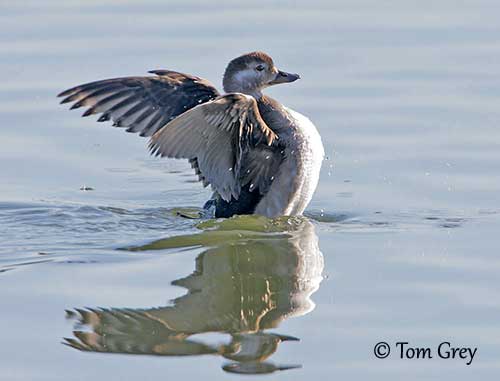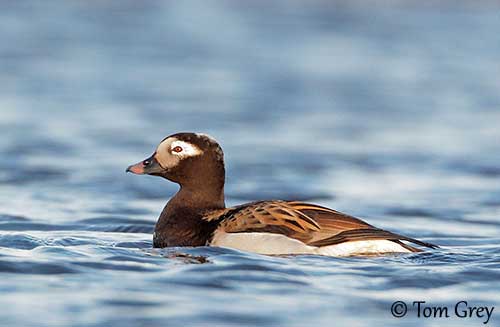
Fr: Harelde boréale - Harelde kakawi
Ang: Long-tailed Duck - Oldsquaw
All: Eisente
Esp: Pato Havelda
Ita: Moretta codona
Nd: IJseend
Sd: Alfågel
Photographers:
John Anderson
John Anderson Photo Galleries
Steve Garvie
RAINBIRDER Photo galleries & Flickr Rainbirder
Tom Grey
Tom Grey's Bird Pictures et Tom Grey's Bird Pictures 2
Tom Merigan
Tom Merigan’s Photo Galleries
Otto Plantema
Trips around the world
Nicole Bouglouan
PHOTOGRAPHIC RAMBLE
Text by Nicole Bouglouan
Sources:
HANDBOOK OF THE BIRDS OF THE WORLD vol 1 by Josep del Hoyo-Andrew Elliot-Jordi Sargatal - Lynx Edicions - ISBN: 8487334105
THE COMPLETE BOOK OF BRITISH BIRDS – Written by “Royal Society for the Protection of Birds” experts - Préface de Magnus Magnusson - Michael Cady- Rob Hume Editors - ISBN: 0749509112
THE HANDBOOK OF BIRD IDENTIFICATION FOR EUROPE AND THE WESTERN PALEARCTIC by Mark Beaman, Steve Madge - C. Helm - ISBN: 0713639601
L’ENCYCLOPEDIE MONDIALE DES OISEAUX - Dr Christopher M. Perrins - BORDAS - ISBN: 2040185607
ENCYCLOPEDIE DES OISEAUX DE FRANCE ET D’EUROPE – de Peter Hayman et Rob Hume - Flammarion – ISBN : 2082009920
GUIDE DES CANARDS, DES OIES ET DES CYGNES – de Steve Madge - Delachaux et Niestlé - ISBN: 2603013769
All About Birds (Cornell Lab of Ornithology)
Animal Diversity Web (University of Michigan Museum of Zoology)
Bird Web (Seattle Audubon Society)
What Bird-The ultimate Bird Guide (Mitchell Waite)
Long-tailed Duck
Clangula hyemalis
Anseriformes Order – Anatidae Family
INTRODUCTION:
The Long-tailed Duck is included in the tribe Mergini within the subfamily Anatinae. With the Harlequin Duck, it is often supposed to be a new link between the eiders and the rest of the tribe.
This species occurs in the cold northern waters and it is one of the most abundant ducks in the high Arctic.
Unlike most diving ducks, the Long-tailed Duck uses its partially folded wings to propel itself underwater. It spends most of its time below the surface and can dive as far as 50-55 metres depth when foraging.
This species is a small diving duck that shows four different plumages over the year. However, in all plumages, the male has the pointed tail with longer, slender central rectrices.
The Long-tailed Duck is Vulnerable and threatened by habitat loss and petroleum pollution, entanglement in fishing nets and hunting pressure during the migration.

DESCRIPTION OF THIS SPECIES:
Biometrics:
Length: M: 51-60 cm with tail of 13-15 cm – F: 37-47 cm
Wingspan: 73-79 cm
Weight: M: 650-900 g – F: 550-800 g
The Long-tailed Duck shows up to four plumages over the year, with summer, autumn, winter and eclipse plumages. The two latter appear after the breeding season.
The adult male in breeding plumage (summer) has black head, neck, breast and wings. The face is grey, forming a patch around the eyes which are surrounded by white eyering, extending to the ear-coverts.
On the upperparts, the long black feathers are broadly edges buffy. The black central rectrices are very long. The underparts are white except the black breast and the underwing coverts.
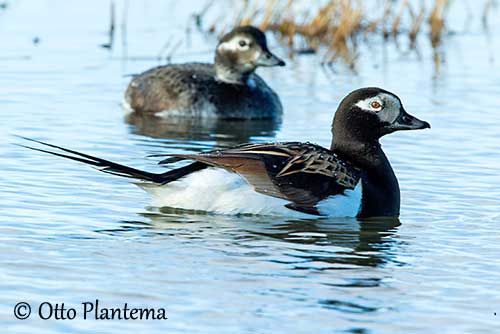
The adult male in winter plumage has white head and neck. The grey face patch is still visible, but the white eyering is restricted to the eyes. There is a large, rounded, black spot extending from cheeks down to the neck sides. Lower foreneck and breast are black and the back too, the latter with long, pointed, pale grey feathers. The tail shows very long, black central rectrices. The underparts are pale grey except the black breast and the underwing coverts.
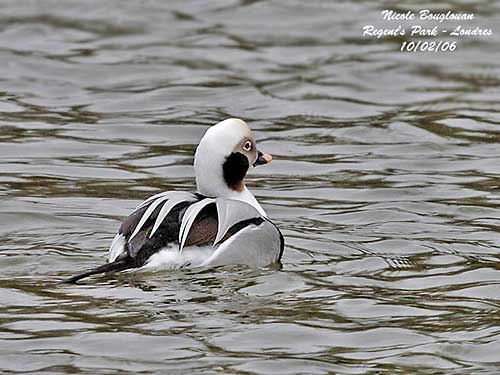
In summer and winter, the bill is black with broad, subterminal pinkish/reddish band. The eyes are brown orange. Legs and webbed feet are grey.
During the eclipse plumage, the bill is mostly black. The seasonal variations are complex.
The adult female in breeding plumage (summer) has dark head and neck, with white eyering extending behind the eye into a white stripe down to the neck sides. Breast and back are brown with variable buffy-edged feathers, especially on the back. Rest of underparts is white. The tail is black above and white below and on the sides.
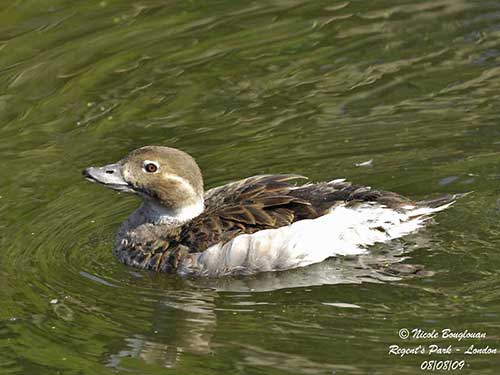
The adult female in winter plumage has white head and neck, and dark brown cheek patch. Crown, breast and back are variably brownish-grey. Rest of underparts is white.
The bill is black. The eyes are brown orange. Legs and webbed feet are grey.
The juvenile has dark brown head with broad, white eyering extending to the ear-coverts, white nape and neck collar. The upperparts are variably brownish-grey with buffy-edged feathers on back and upperwing-coverts. Breast and upper belly are brownish-grey too, while rest of underparts is white. The bill is blue-grey.
The immature resembles adult of same sex.
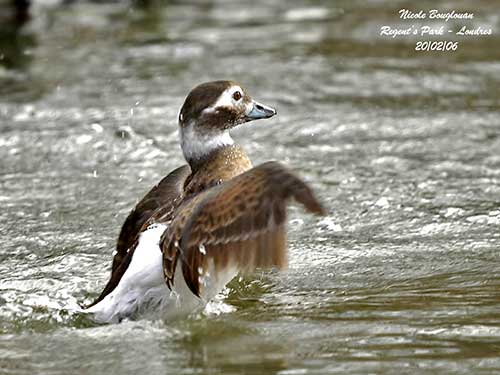
RANGE:
The Long-tailed Duck has circumpolar distribution. It breeds on the Arctic coasts of North America including Alaska, Canada and Greenland, Europe (Scandinavia) and Asia (Russia).
It winters S as far as Oregon, Great lakes and N Carolina in the USA, SW Greenland, Iceland, Britain, Baltic and North Seas. In the Pacific Ocean, it winters from Kamchatka S to Korea, and on several inland areas.
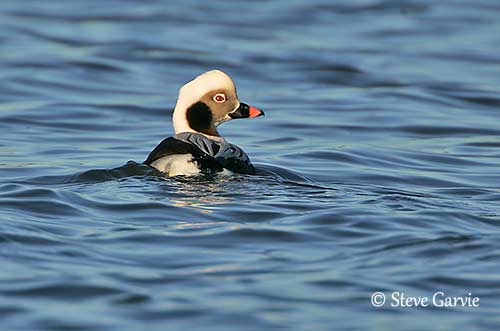
HABITAT:
The Long-tailed Duck breeds close to tundra pools and small lakes, slow rivers and coastal inlets. It can be seen on low-lying tundra, hilly areas, barren ground and forest edges, but always with nearby open water.
Outside breeding season, it occurs mainly in coastal waters including from shores among the pack ice. It is rarely found on fresh water during this period.
CALLS AND SONGS: SOUNDS BY XENO-CANTO
The Long-tailed Duck male is very vocal during the courtship displays. It utters loud, yodelling “ow-OW-owlee… caloocaloo”. The female produces various weak quacking notes.
When in flocks, they call together, giving far-carrying, loud, melodious calls.
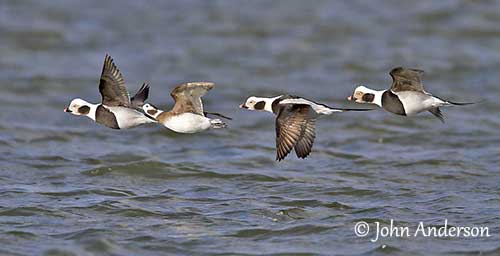
BEHAVIOUR IN THE WILD:
The Long-tailed Duck feeds on various aquatic preys. During the breeding season, it takes primarily aquatic insects, but also crustaceans and molluscs, fish eggs and plant material such as grasses and pondweeds.
During the winter, it feeds mainly on molluscs (mussels, clams and periwinkles) and crustaceans such as isopods and amphipods, and occasionally small fish.
The Long-tailed Duck forages by diving and swimming underwater. This species can dive up to 50-55 metres depth, deeper than any other Anatidae species. It propels itself with semi-open wings and feet. The dive may last 25 to 60 seconds during which it pursues and catches the prey.
During the breeding season, the males fight, using calls, physical contact, chases by running fast at water surface, and visual displays involving spreading wings and tilting head upwards.
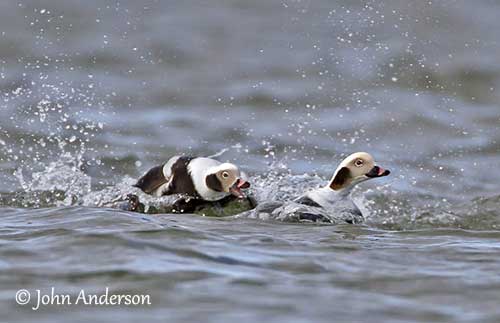
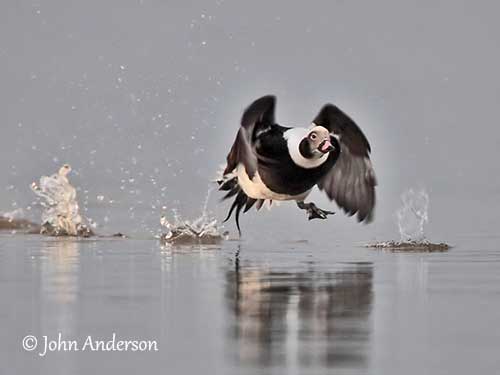
The pair forms often in autumn, and more generally, they are already paired when they return to their breeding grounds. They are monogamous and the same pair may re-forms for several following years, or only a single season.
The male performs elaborate courtship displays, approaching the female with raised tail and bill held outwards but close to the water. It bows and pulls its head back with the bill held upwards, while uttering series of 4-5 deep calls.
The female responds by calling too, and holds her head close to the body to indicate availability. Then, male and female reach a mating location.
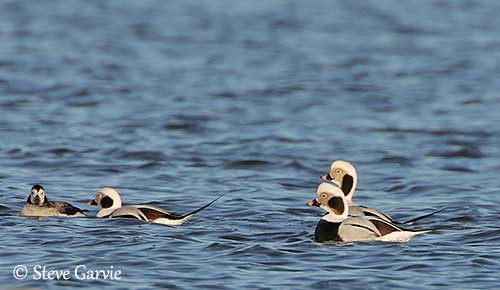
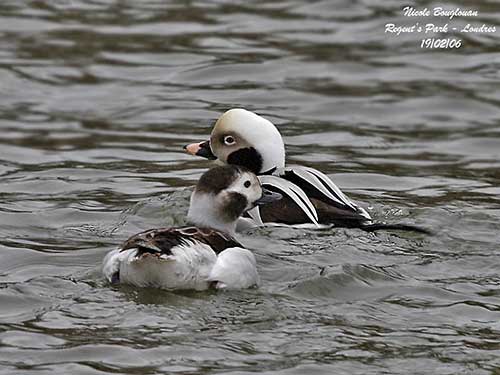
The Long-tailed Duck is migratory and moves in large flocks by night. The autumn migration occurs after the moulting period. Males and females gather in flocks during their flightless period, and usually complete their migration in groups. The young birds form large groups after moulting, until they perform their first migration.
They migrate S in early September, and return to N in early May.
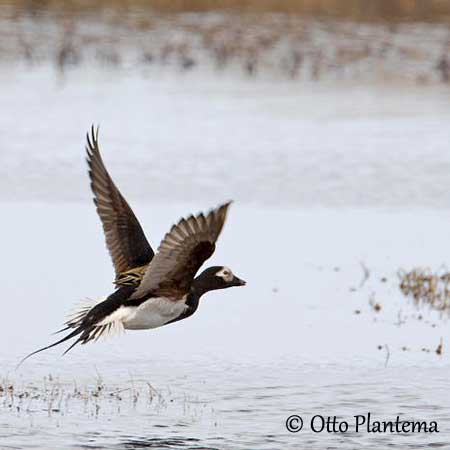
The Long-tailed Duck often flies low over water with erratic side-to-side turns of body. The flight is fast and direct with shallow wingbeats on stiff arched wings.
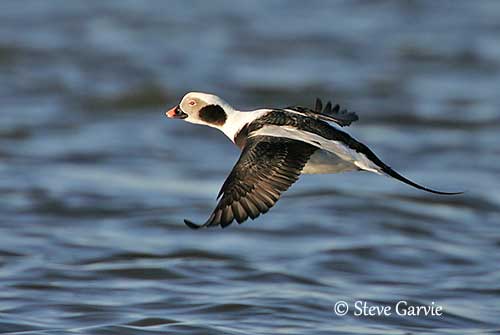
REPRODUCTION OF THIS SPECIES:
The Long-tailed Duck breeds as soon as the breeding grounds are free of ice, often in May/June but mostly in late June. It breeds in single pairs or loose groups.
It nests on the ground, in the open or among the vegetation, on island in freshwater pool, but generally close to the water.
The nest is a shallow depression lined with dark down. The brown plumage of the female makes her very cryptic on the ground and almost invisible.
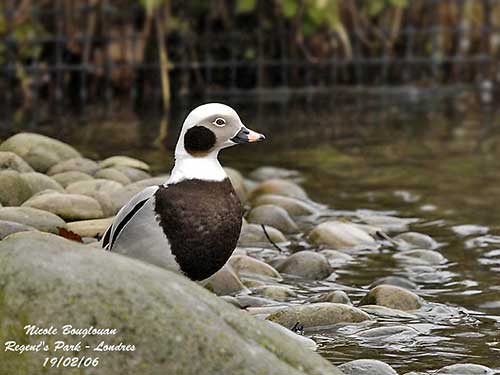
She lays 5-9 pale green eggs and incubates alone during 24-29 days. The male leaves her at the beginning of the incubation and reaches the coast for moulting. At hatching, the chicks are dark chestnut-brown above and white below. Cheeks and eyes’ area are white too and they have a dark breastband. Soon after hatching, they follow the female to the nearest freshwater pond. They fledge 35-40 days after hatching and become independent.
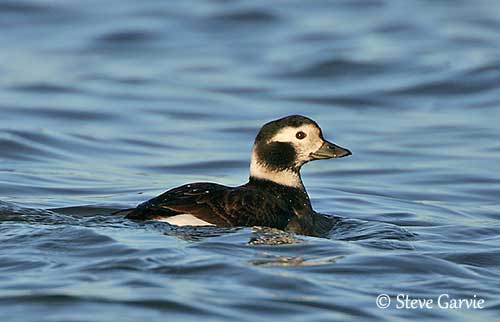
PROTECTION / THREATS / STATUS:
The Long-tailed Duck’s nests are often attacked by the Glaucous Gull, the Arctic Skua (Parasitic Jaeger) and the Arctic Fox, whereas the adults are predated by the Gyrfalcon. The dense concentrations of birds at sea are vulnerable to oil spills, and numerous birds are caught and killed in fishing nets. They suffer hunting pressure over some Arctic regions during their migration. Degradation and drainage of wetlands are important threats too.
The global population was evaluated to number 6,200,000/6,800,000 individuals in 2006. This population is declining in some areas including Baltic Sea (1990s), Greenland, Iceland, East Siberia and North America.
Due to these reasons, the Long-tailed Duck is currently classified as Vulnerable.
